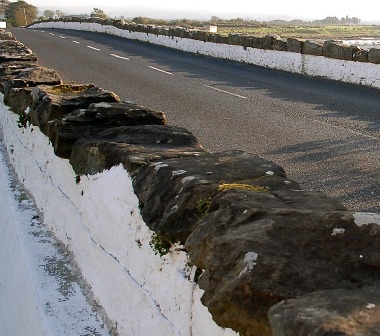By Tom Finnigan
You know that summer is approaching Malin Town, when white-wash appears on the bridge’s parapet and brushes scrub walls. Other places count swallows; we look for immaculate stones. When the rim surrounding our triangular green gleams white, the matter is fixed: summer has arrived.
I carry a pint from Maclean’s and sit on a bench near the Food Store and watch sunlight coax colour from the flowerbeds on the green. Outside the Malin Hotel, a couple sprawl under an awning and smoke. Beech trees cast shadows across the green. Seated majestically on a mower, Hughie sweeps past me and waves. A smell of cut grass follows him.
A van turns from the Glengad road. The enlarged face of a politician grins from its panels. In a stink of exhaust fumes, a microphone blares and a voice bleats for support in the coming election. The van circles the town and exits across the bridge to annoy sheep on the Carn road.
On August 7th in 1843, it was reported, thousands of people assembled near the Green Hill, outside Malin, to listen to Daniel O’Connell. The authorities feared violence and hid behind the muskets of the military but all passed quietly and J. McSheffry Esquire had no regrets about allowing his land to be used for a political gathering. “But,” a local historian remarked: “The great agitation has gone for naught…and Ireland groans under the burthen of her sorrows.”
The Psalmist says that man is like grass in a field. He grows in the sun, then withers and dies. Shinnere and Finners; Blueshirts and the Loose-your-shirts; Labour and Independents: they are blades of grass. Their sun has set. Who will remember the names of the defeated when the placards rot and the loud-speakers are silent? A few lines in the local papers, comment on Highland radio, an argument over drinks. For a few weeks their faces haunt us from telegraph poles and lamp-posts. Votes cast, they are lifted down and thrown into the back of a van to be re-cycled at ten euro a time. Those left hanging, wait for wind or rain to throw them into the dirt under a whin bush. Remember man that thou art dust and to dust thou shalt return…
Free of electoral blather, Malin resumes the tranquillity of summer. A swallow flits under oaks. The church of Ireland raises its castellated tower behind a copper beech as it has done since 1827. Outside Maclean’s, two old carousers sit on the wall by the bridge and watch a girl in shorts fill her car with petrol.
Politicians lick wounds, newspapers castigate the clergy and the banks are bust. Let the world go about its business. Be still, relax; sit on a bench under a sycamore tree at the edge of the green with a pint to hand and listen to a tractor lifting silage along the Lagg road. Gaze at what a Planter built and be thankful for white-wash and brushes – those perennial signs of summer in Malin.
Tom Finnigan writes his essays from his home in Malin, Inishowen, County Donegal, Ireland.


